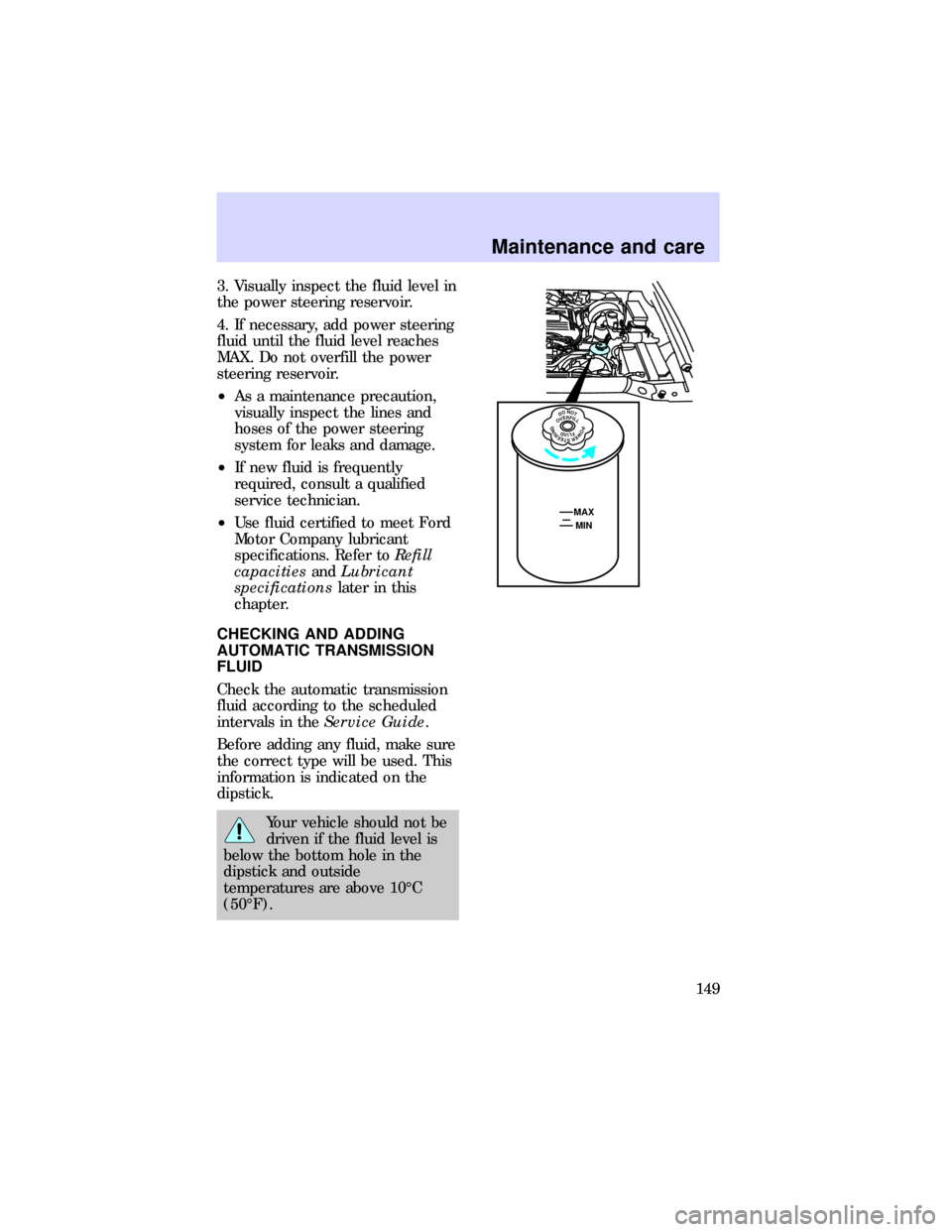service interval Mercury Mountaineer 1997 Owner's Manuals
[x] Cancel search | Manufacturer: MERCURY, Model Year: 1997, Model line: Mountaineer, Model: Mercury Mountaineer 1997Pages: 197, PDF Size: 2.08 MB
Page 105 of 197

that could damage drive
components.
If the transmission and transfer
case are submerged in water, their
fluids should be checked and
changed, if necessary.
All rear axle lubricants must be
replaced every 160,000 km
(100,000 miles) or if the axle has
been submerged in water.
Otherwise, check the lubrication of
the rear axle according to the
intervals in theService Guide.
Driving on hill or slope terrain
When driving on a hill, avoid
driving crosswise or turning on
steep slopes. You could lose
traction and slip sideways. Drive
straight up, straight down or avoid
the hill completely. Know the
conditions on the other side of a
hill before driving over the crest.
When climbing a steep hill, start in
a lower gear rather than
downshifting to a lower gear from
a higher gear once the ascent has
started. This reduces strain on the
engine and the possibility of
stalling.
When descending a steep hill avoid
sudden braking. Rapid pumping of
the brake pedal will help slow the
vehicle and still maintain steering
control.
When speed control is on and you
are driving uphill, your vehicle
speed may drop considerably,
especially if you are carrying a
Driving
105
Page 115 of 197

Servicing while towing
If you tow a trailer for long
distances, your vehicle will require
more frequent service intervals.
Refer to theService Guidefor
more information.
Trailer towing
²Practice turning, stopping and
backing in an area before
starting on a trip to get the feel
of the vehicle/trailer
combination. When turning,
drive slightly beyond the normal
turning point so the trailer
wheels will clear curbs and
other obstacles.
²Allow more room for stopping
with a trailer attached.
²The trailer tongue weight should
be 10-15% of the loaded trailer
weight for a Class I or II rear
bumper hitch.
²After you have travelled about
80 km (50 miles), thoroughly
check your hitch, electrical
connections and trailer wheel
lug nuts.
²When stopped in traffic for long
periods of time in hot weather,
place the gearshift in P (Park)
to increase idle speed. This aids
engine cooling and air
conditioner efficiency.
²Vehicles with trailers should not
be parked on a grade. If you
must park on a grade, place
wheel chocks under the trailer's
wheels.
Driving
115
Page 147 of 197

1. Before you remove the coolant
recovery cap, turn the engine off
and let it cool. Even when the
engine is cool, be careful when
removing the recovery cap. Wrap a
thick cloth around the cap for safe
removal.
2. When the engine is cool, lift the
cap.
3. Step back while pressure
releases.
4. When you are sure that all the
pressure has been released,
remove the recovery cap.
5. Stand away from the reservoir
opening; hot steam may blow out
or hot engine coolant may even
splash out.
6. Add engine coolant until the
level is between the MAX and MIN
lines on the engine coolant
recovery reservoir.
Follow the recommended service
interval for changing engine
coolant as outlined in theService
Guide. For coolant recovery
reservoir capacity, refer to
Lubricant specificationsin the
Capacities and specifications
chapter.
RADIATOR
COOLANT
ONLY
MAX
MIN
Maintenance and care
147
Page 149 of 197

3. Visually inspect the fluid level in
the power steering reservoir.
4. If necessary, add power steering
fluid until the fluid level reaches
MAX. Do not overfill the power
steering reservoir.
²As a maintenance precaution,
visually inspect the lines and
hoses of the power steering
system for leaks and damage.
²If new fluid is frequently
required, consult a qualified
service technician.
²Use fluid certified to meet Ford
Motor Company lubricant
specifications. Refer toRefill
capacitiesandLubricant
specificationslater in this
chapter.
CHECKING AND ADDING
AUTOMATIC TRANSMISSION
FLUID
Check the automatic transmission
fluid according to the scheduled
intervals in theService Guide.
Before adding any fluid, make sure
the correct type will be used. This
information is indicated on the
dipstick.
Your vehicle should not be
driven if the fluid level is
below the bottom hole in the
dipstick and outside
temperatures are above 10ÉC
(50ÉF).
DONOTOVERFILLPOWERSTEERINGFLUID
MAX
MIN
Maintenance and care
149
Page 161 of 197

when tires are cold (after the
vehicle has been parked for at
least one hour or driven less than
5 km (3 miles).
The cold pressure amount is listed
on the Safety Compliance
Certification Label located on the
inside driver's door latch pillar.
Improperly inflated tires
can affect vehicle handling
and can fail suddenly, possibly
resulting in loss of vehicle
control.
Rotating your tires
Rotate your tires at regular
intervals to ensure even wear.
Rotation intervals are listed in the
Service Guide.
Your wheels and tires are
match±mounted for improved ride.
Before you begin a tire repair,
mark the wheel and tire to ensure
proper alignment when
remounting.
Maintenance and care
161
Page 169 of 197

your vehicle to comply with
applicable exhaust emission
requirements. For more
information on your vehicle's
emission control system, see the
Vehicle Emission Control
Information decal located on the
left side of the engine
compartment.
Follow these guidelines to ensure
proper emission system operation:
²Use only unleaded fuel.
²Avoid running out of fuel.
²Do not turn off the ignition
while your vehicle is in motion.
²Have the services performed
according to the intervals in the
Service Guide.
When servicing your vehicle, never
use a metal exhaust collector. A
metal collector may melt or deform
plastic parts.
Do not park, idle, or drive
your vehicle in dry grass
or other dry ground cover. The
emission system heats up the
engine compartment and exhaust
system, which can start a fire.
On vehicles without
original equipment floor
covering or insulation, do not let
passengers ride in your truck in
a manner that allows contact
between skin and the metal floor.
Maintenance and care
169